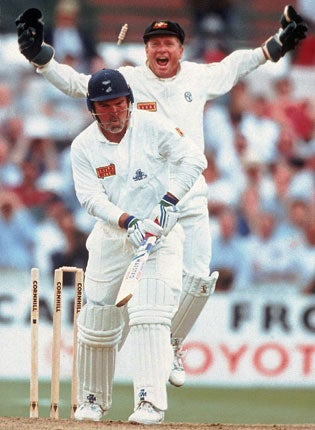Ian Herbert: The travelling circus may be inclusive but it sells the spectacle of Test cricket short
Dress up your stadium however you want, but it doesn't give it the aura that makes it an opener's dream to see his name on the honours board

Yes, it's true that the Sri Lankans are getting through captains faster than Fabio Capello. And yes, we do now have an Andrew Strauss mini-crisis to manufacture some tension. But at times this summer's international cricket has felt like the biggest non-event since the George Davis liberation campaign did for the last day of the 1975 Ashes Headingley Test.
It's not the cricket that's the problem. If nothing else, this will always be the summer of Ian Bell's beautiful little innings at Lord's. It's the location. The Hampshire Rose Bowl is beautiful – all that billowing white fabric over the pavilion end stand and the bucolic southern English hills rolling away in the distance – but, at the risk of signing up to the Geoffrey Boycott school of yesteryear, it just doesn't feel like a landscape of international cricket. England demands a cauldron, not a rose bowl.
If it's the natural environment you seek, then go to Newlands in Cape Town. If it's an atmosphere befitting England's current strides toward becoming the top Test nation, then it must be the theatres which carry some of the thrilling memories of cricketing legend: Old Trafford (the Laker Test, July 1956, or Warne's "Ball of the Century" 37 years later); Trent Bridge (Allan Donald v Atherton, July 1998); Headingley (Botham v Australia, July 1981); Edgbaston (second Ashes Test, August 2005).
Cardiff, Chester-le-Street, Southampton – all fine places and there's something commendably inclusive about stadiums which place you so close to the action that you hear third man cursing the bowler's length. But intimacy is not the same as intensity. Dress up your stadium however you want – and the Emirates Durham ICG certainly sounds less genteel than the Riverside, Chester-le-Street – but it doesn't give it the aura that sends statisticians rooting for the record sixth-wicket stand on that turf or makes it an opener's dream to see his name on the honour board.
Spreading the matches around was supposed to make Test cricket more inclusive. But this summer will see no Tests north of Trent Bridge and, where once you knew that to visit the Test was to venture into the great inner-city stadiums, it's increasingly likely to be a trip out of town, like a visit to the baseball or B&Q. If the objection to all this might be that it's time to open up cricket to the next generations in Hampshire, Durham or South Glamorgan, then what is the most likely source of inspiration to those in the backstreets of Southampton: a day of Test cricket their parents can't afford or a thriving county cricket team down the road? Durham have managed both but Sussex has spawned a generation of Mushtaq Ahmeds without staging a Test.
When these new places joined the dash for a slice of Test cricket, it felt like enfranchisement; an end to the divine rights of the kings of cricket's establishment. But instead, the counties became prisoners; developing their grounds and suddenly mortgaged to that uncertain hope of winning a box office fixture which the elements and fates would hopefully not ruin.
It's a simple problem of mathematics, though. There are not enough Tests to go around. Glamorgan's costly bids for international matches, partly financed by the Welsh Assembly to general English irritation, have delivered the county's first losses in four years because its allocated T20 fixtures were shadowed by match-fixing allegations. Yorkshire has suggested it won't even bid for an Ashes Test in 2013 and 2016 because the financial gamble is too great.
And then there's Lancashire, a county brought to the verge of bankruptcy. The county's chief executive, Jim Cumbes, is an old swing bowler but has known few curveballs like those which have been served up by his attempts to redevelop Old Trafford to compete for Tests. The relatively easy part has been the re-establishment of the square on a north-south axis. Then came the unnerving legal battle over the £32m redevelopment of Old Trafford, which involves two new grandstands – taking capacity to 15,000 permanently and 25,000 for England matches. Two weeks today, Cumbes will go to the Court of Appeal to hear whether the property company Derwent Holdings, owner of the nearby White City retail park, has been successful in preventing Lancashire's development, which substantially depends on Tesco putting £21m into Old Trafford.
Cumbes, whose planning and legal bill is heading toward £2m, says 4 July is a "day of destiny". But here's the rub. Having gone to the brink to make their stadium a competitive Test venue, Lancashire still face ruination if they are denied a 2013 Ashes Test. For now, we can only hope they get by on their little Tesco Extra help.
The Australians are less indifferent to their cricketing theatres. The same venues – Brisbane, Perth, Adelaide, Sydney and Melbourne – tend to feature on their Test roster, with Hobart a more regular addition. It's time for England to see sense, too, and return its Test to the best: Headingley and Old Trafford in the North, Edgbaston and Trent Bridge in the Midlands, Lord's and The Oval in London. Hampshire, whose initial Rose Bowl project costs of £18m have risen to over £30m, won't agree because they've placed their bet now. But when the Test bandwagon leaves town tomorrow and the rain perhaps clears, the locals may look at a County Championship First Division table featuring Hampshire at rock-bottom and wonder if it was all worthwhile.
Join our commenting forum
Join thought-provoking conversations, follow other Independent readers and see their replies
Comments